Store fresh bread in a cool, dry place away from excess heat, moisture and air. Paper, plastic bags & bread boxes? They all work. Here’s how to do it- without mold.
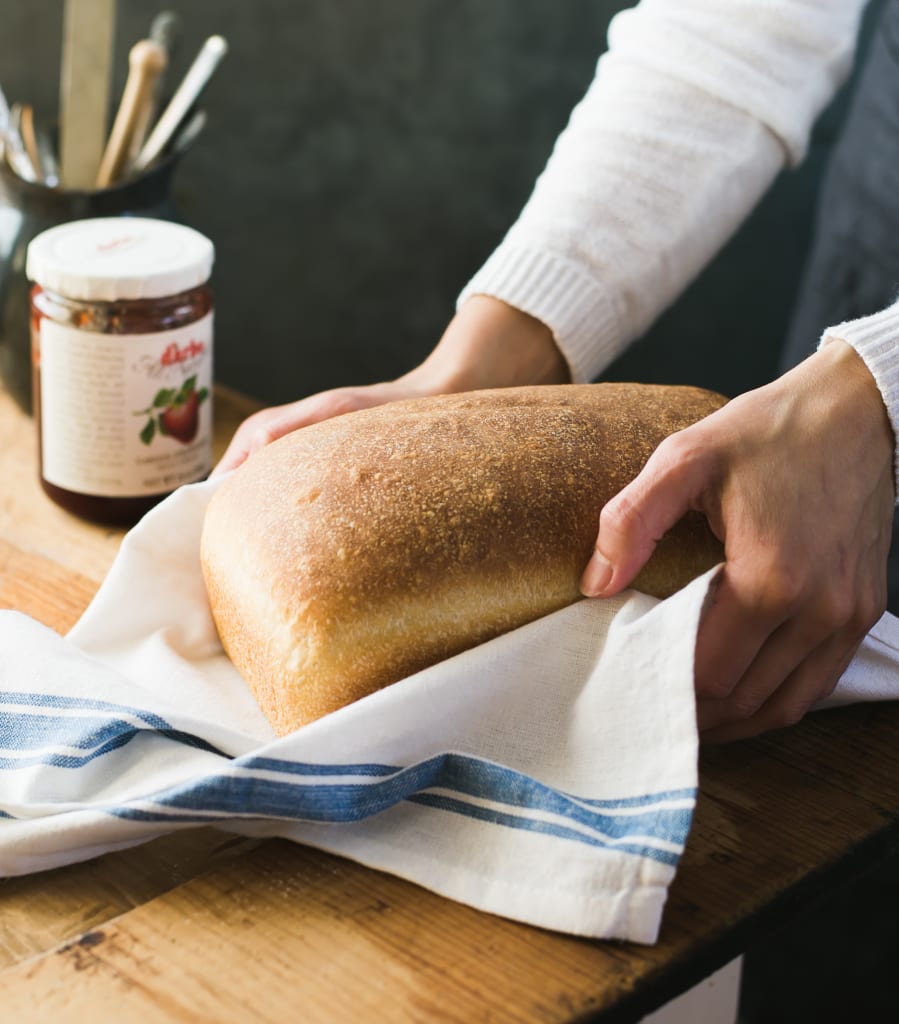
Make no mistake: Fresh bread is best.
The question is, how long will it last? Without preservatives? And what about mold? Here are my top tips for storing bread, keeping it fresher for longer.
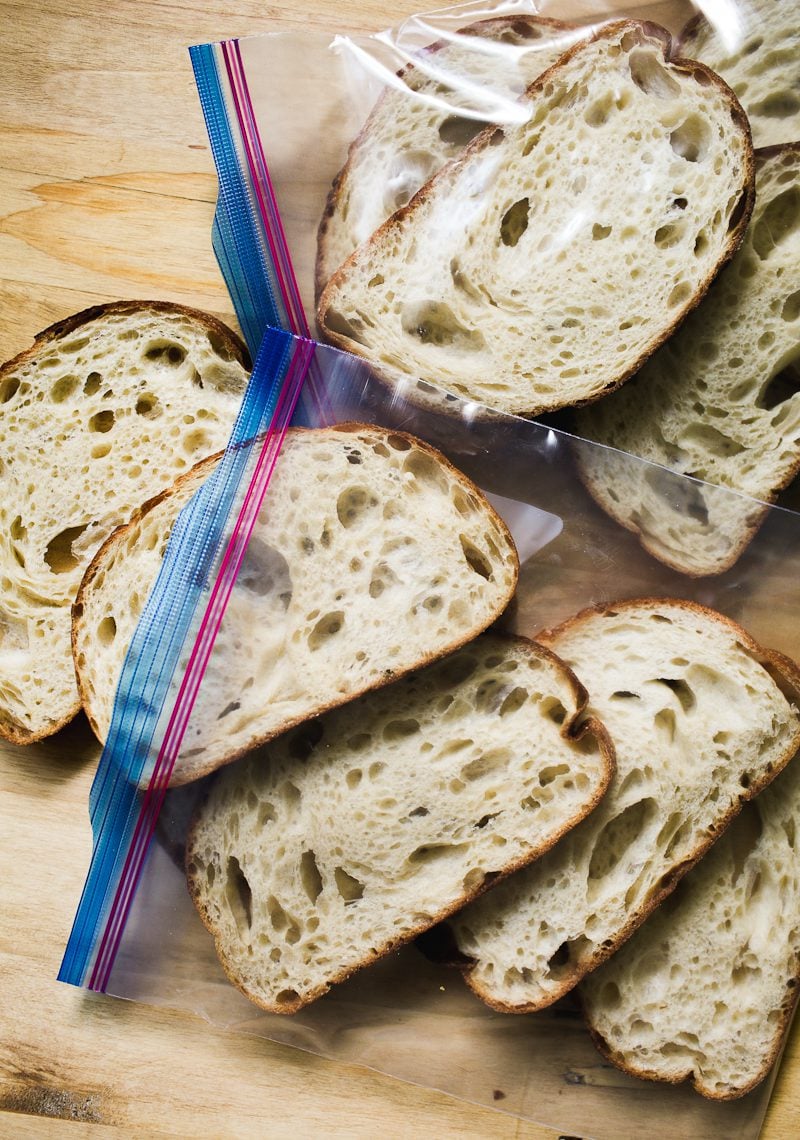
When in doubt, this is your best storage/preservation option.
Fresh bread can be frozen whole or cut into slices. Wrap whole loaves in several layers of plastic wrap, label, date and freeze.
For bread slices, store in a zip-top bag separated by parchment paper to prevent sticking (or throw caution to the wind and dump everything together- that’s what I do).
Frozen bread will stay fresh for up to 3 months or longer, or whenever freezer burn sets in. You’ll love having a stash on hand to make garlic bread, quick sandwiches, and homemade croutons.
Tip: How to defrost frozen bread. Defrost whole loaves or cut slices overnight in the fridge, or at room temperature for a few hours. If the bread has icy bits stuck to it here and there, remove the wrapping to prevent the crust from getting soggy. To serve, reheat at 300˚ F (150˚ C) or toast until crispy.
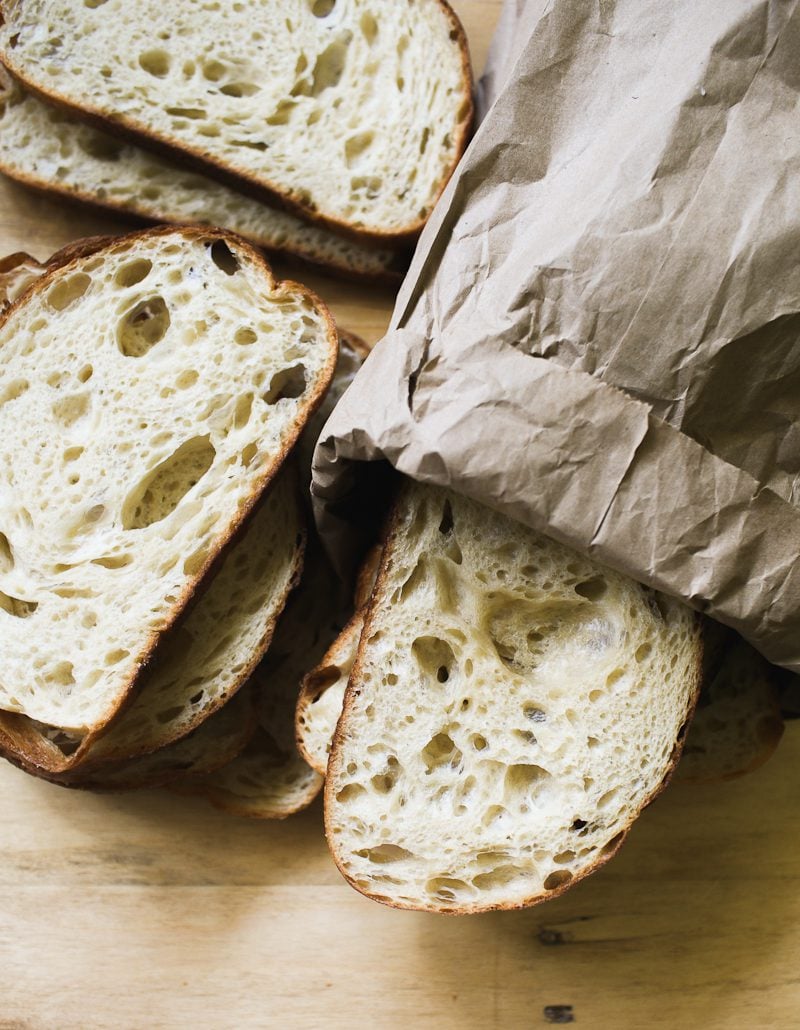
They all work. In my experience however, freshness depends on the type of bread stored.
For example, sandwich bread does well when stored in a plastic bag; it locks in moisture which keeps the crust soft. But too much moisture will create mold, so I’ve found it’s best not to keep the bag airtight. Loosely twist the end to close.
Paper bags are more breathable than plastic, which is great for brioche rolls, soft buns, and other breads with added fat. But too much air will make the bread go stale quickly. Consider keeping these bags airtight as best you can.
Then there’s the bread box: it balances moisture and air circulation. The only caveat? They’re bulky and take up valuable counter space. I don’t have one, but many bakers swear by them. I’ve heard using a Dutch oven or bread pan is an effective alternative.
Bottom line? You need both moisture and air to guarantee freshness.
TIP: My storage preference. I use large, food-grade plastic bags. They are the perfect size for sandwich bread and larger boules. I reuse them as produce storage for my CSA veggies.
Most bakers recommend storing bread in a cool dry spot, at room temperature. Why? Excess heat and moisture creates mold, and too much air creates stale bread. So yes: a cool dry spot such as a pantry shelf works. I just leave my bread on the counter.
However, fresh bread can in fact be stored in the fridge, contrary to what you might’ve read online (I never used to recommend this myself!). We do this at our restaurant with excellent results.
TIP: How to refrigerate bread. Wrap whole loaves in several layers of plastic wrap and chill for up to 2-3 days. Reheat before serving, otherwise the texture will be rubbery: Warm the bread at 300˚ F (150˚ C) in a foil packet or naked, extending the bake time to crisp the crust, about 20-30minutes.
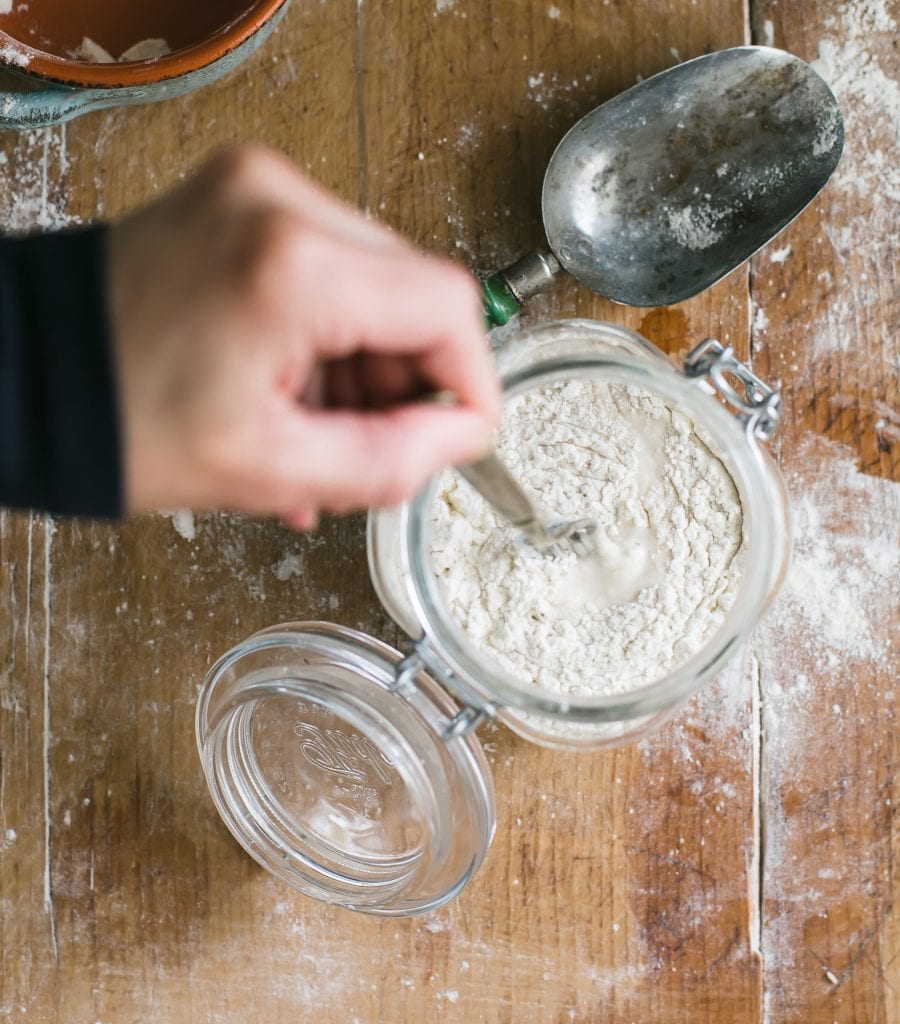
Sourdough bread is an excellent example of naturally preserved bread. The existing enzymes and bacteria help to keep your bread fresh. Additionally, a bit of fat in the dough such as butter or oil, will also extend its shelf life. A good example is sourdough sandwich bread.
Mold loves heat, moisture and food sources. For best results, keep your bread away from excess heat and humidity. Keep it away from the stove, off the top of the fridge, away from the fruit bowl etc.
Years ago, we used to keep our bread in a plastic bag, in a drawer nestled in-between the dishwasher and fridge. The excess heat from the two appliances, plus the moisture locked in the plastic bag, created the perfect storm for mold to grow. Everything in that drawer was covered in green hairy spots- rolls, tortillas, raisin bread- you name it!
Final Thoughts
As always, expect a bit of trial and error when storing fresh bread. Different variables such as bread type, temperature, storage material etc. need to be considered for best results. But the tips above will get you well on your way. Do comment below with your favorite storage tips, too!
*This post contains affiliate links. Thanks for the support!*
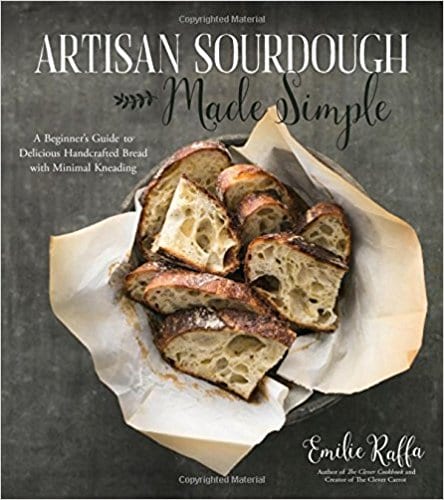

Comments
Shirley DeGeorge says
OH! Happy Surprise, I finally found you online! I bought your Book about 4 years ago, I am thrilled to have you in my Sourdough online world! I printed your breadcrumb recipe. Here’s my question: Do they absolutely have to be stored in the freezer?
Emilie Raffa says
Hi Shirley! Yay! That makes me so happy. For the breadcrumbs, if they contain cheese (Parm, Pecorino etc.) or fresh herbs store them in the freezer. Plain breadcrumbs without add-ins can be stored in an airtight container if you prefer.
Carol C says
I place my cooled, freshly-baked breads in a parchment paper envelope (I simply wrap the bread in parchment paper) then place it in a plastic ziploc bag, leaving the end of the ziploc open. Then I store it in my bread box…the bread is usually eaten in 3-4 days but it’s always super fresh and no mold. Thanks again!
Christel Blumer-Buell says
I’ve been making sourdough bread for two plus years now. I’ve never had the big holes and super oven spring until today using your Light Whole Wheat Sourdough Bread recipe! Wow what a pleasant surprise as I was about to give up on achieving those qualities in my bread. I was amazed! I am learning how critical the temperature is. I live in Hawaii with warm humid temperatures.
Thank you Emilie.
Emilie Raffa says
That’s fantastic! You’re very welcome :) Sourdough is trial, error and tons of repetition! And temperature is huge. Two bakers can follow the exact same recipe, weighing their ingredients to a T, using the same flour etc… but if there temperature is not the same (and of course, overall handling too) the loaves will come out completely different. Incredible, right?
Betsey Carle says
I live in Portland, Oregon, have your sourdough book and have been baking sourdough for over a year. My results have varied, but are always tasty. My experience making 1-2 loaves of basic weekly has included poor oven rise (overproofing) and inconsistent/too large holes in the bread. My tips include turning on the oven LIGHT (not oven turned on) and letting the dough rise during the bulk rise. The energy released in that warm but not hot environment allows the rise to occur naturally. I also do NOT score the loaf before baking, as that helps the loaf attain a good rise. Now my only problem is that I have too many, very large holes in the bread! Suggestions?
Teresa says
Maybe try a cooler rise? put the light on an hour before you put the bread in, but then turn it off the the rise. It will rise slower and maybe smaller air pockets. I do a cool rise all the time. Not warmth other than the heat in the kitchen.
Shammy Peterson says
I found it helpful when you said that bread can be cut into slices or be frozen in whole in order to keep it preserved. This is a good tip for my mother because she mentioned yesterday afternoon that she is planning to have buns delivered to her house this coming Friday. I understand that she is planning to buy in bulk, so your storage tips are helpful.
Emilie Raffa says
Wonderful! I’m glad you found the tips and suggestions helpful, Shammy.
Karen Irmscher says
So far (Next attempt will be my 8th) I have been unable to get sufficient rise. I start with fresh and bubbly starter. Am using a mix of bread flour and maybe 1/3 whole wheat flour. I let it all sit for either the prescribe length of time, or even longer. I like how it tastes and digests, but it keeps coming out heavy and dense, with some internal bubbles but not enough.
I live in Oregon. Our house is in the mid 70’s in some areas, colder in others. I have a bread thermometer arriving today that may be helpful. I’ve tried an ice chest with a heating pad in it, but it may be too warm. Now I’ll be able to check that. I’ve tried turning on the oven briefly at a low heat, turning it off, putting the dough in there for bulk rise and later rise.
Do you have other suggestions?
Emilie Raffa says
Hi Karen! Yes: it might be the length of your second rise. If it goes for too long, the dough will lack sufficient oven spring, especially after a longer bulk rise. Are you doing this step at room temp? Or chilled overnight in the fridge?
Karen Irmscher says
Thanks for your response. Second rise is definitely the problem. I don’t refrigerate. Your instructions say to let it double in size. It never does, so I keep waiting. I’ve thought of mixing a little powdered yeast in with the sourdough starter at the beginning, or doubling the amount of sourdough starter. The thermometer I just got seems to go off after a short time. I was hoping it would stay on so I could work at keeping the temp between 70 and 80 degrees F. Is there one you can recommend that stays on for easier tracking?
Room temp in my house varies a lot. We have one ductless heat pump in the downstairs which we supplement with wood stove heat when outside temps drop below 40. Warmest area is under the heat pump, so I’ve tried the bowl of dough there, as well is in an ice chest with heating pad and the oven, turned on for a few minutes at 250 then turned off. Dry air, but I have the damp dish towel on top.
I keep thinking of those old sourdough miners who most certainly didn’t have a uniform heat source and still managed. Maybe their bread was dense, but I imagine they would have eaten it anyway. Which I do for a few days. But I want mine to look more like yours. I bought your book after checking it out from the library because I wanted to eat everything in it. Still do.
Emilie Raffa says
The second rise is not supposed to double in size (only the bulk rise). This is probably where you are running into issues. I would shorten this step. I have a feeling your dough is over proofed, which is why you are not able to get a good rise in the oven and the texture is dense. Also, try using really warm water in your initial mix (95 F). This will give your dough a boost without the need to add yeast or double the starter. Temperature is important, and there will always be a bit of trial and error with sourdough in a non-temperature controlled environment. Have you thought of purchasing a bread proofing box? This will keep your dough at approximately the same temperature throughout the process.
Shirley DeGeorge says
I’ve just purchased a proofer box and yes! It makes a huge difference! I splurged and bought the Brod & Taylor on Amazon, hated the price but..
Now, 2 weeks later there is a canvas one on Amazon w/temp control and under $25.00! with rave reviews! That “Luck of the Irish” it just arrives always late! Thanks for all your help!
Emilie Raffa says
You are very welcome! I’ve never seen the canvas one… I wonder how good it is?!
Connie C says
Here in the Pacific Northwest (I live in Washington) it is very true – our weather and house temps vary considerably! I think I have found the solution though – I have had great success this winter with two strings of Christmas lights inside a plastic bin, a nice thick one normally used in food services to bus dishes. I leave the lid off, otherwise it actually gets too hot. This setup keeps my starter and my proofing at a nice steady temperature (between 70 and 78F) all day and night. Plus they use very little energy.
My cousin and Mom got me hooked on sourdough over Christmas and I have had great fun making bread since! I too want to eat ALL the Things in your book Emilie. :)
Karen Irmscher says
Thanks, Connie, for your suggestions. I went ahead and purchased an electric, thermostat-controlled proofing box which I got only a few days ago. The first and only time I’ve used it so far, I set the temp at 83 because I’d had good success with a temp in the low 80s on my previous batch. I got it that high by setting the bulk rise bowl on a chair on the dining table under the heat pump.
In the proofing box, the small tray of water between the heating plate and the metal grid on which the bowl sits was supposed keep the top moist enough so no damp towel was needed, but when I got up in the morning the top was crusty. I think it had already maxed out on its rise too, so it rose maybe not at all while baking.
Next trial I will take the temp down to maybe 78 and put a damp towel on top.
Pauline Van Der Velden says
Hello, a lot of great ideas here on bread storage. I don’t like to use too much plastic, so I use foil to wrap my bread, sliced or unsliced, before placing it in the freezer. I wrap it in foil and place it in a ziploc bag. Both foil and bag can be reused. Recently I had a whole loaf sourdough light rye bread that I found in the freezer that I had baked in May. Just last week I took it out, thawed it on the counter, and when I opened it up, it looked like a loaf I had just baked! Sliced it and it was perfect! No freezer burn or dry spots. It was so good.
Dayne Conn says
Great and easy to follow.
Emilie Raffa says
Thank you, Dayne!
Erica says
Would love to know your thoughts on linen bread bags?
Emilie Raffa says
Hi Erica! Linen bags: I have mixed feelings. In my experience, several of my loaves went stale too quickly. However, this could have been due to my bread type, dry weather etc. I’ve found that wrapping the loaves first or even using lined linen bags works best.
Edit to add: additional bakers in this thread have mentioned putting the bread (in the linen bag) inside of a bread box or crock to extend freshness. Great tips!
Meg says
We use a low tech option. Wrap in good quality tea towel….I’ve used cotton bags and tried linen bags, but honestly, yea towel works just fine. I make a new loaf every few days so…..nope, no mould. Love your book, and have lent it out so many times I’m thinking of getting a second copy (people who borrow almost always get their own copy).
Emilie Raffa says
Hi Meg! Yes: tea towels work well. Have you wrapped warm loaves in tea towels for a softer crust? That’s another great tip. I do this sometimes with my sourdough sandwich loaves for the kids.
Margo says
Interesting observations! I store my bread in my homemade beeswax cloths and put them in a bread crock on the worktop. They store well and the crust stays crispy.
Emilie Raffa says
This is an excellent tip, Margo. Thanks for sharing! I love that the loaves are wrapped first and then stored in a crock. Double protection :)
Christine says
I live on a sailboat. I have been hanging my bread bags with a binder clip from a hook. For some reason the bread last longer. (I can’t control the heat and humidity.)
Emilie Raffa says
Christine, I love this! How cool. It sounds like the weather + the bread bag creates the perfect storage vessel.
Kristen says
Hi Emilie,
I store by leftover bread never in straight up plastic.. the crust is sacrificed!
Instead I save cereal wax bags. I store the bread in these for up to 3 days and it stays quite fresh.
Or, I store the cut side down on parchment in a brown grocery paper bag folded over. This method is also a standby.
Emilie Raffa says
Hi Kristen! The other day, I was wrapping something in wax paper and it reminded me of your tip. Very clever! I’m looking forward to testing this out with my bread. Thanks for sharing.
Kelly Sherrill says
I store most of mine in linen bread bags with a drawstring then tucked into a stainless steel bread box in the pantry. Has worked well most of the time with minimal mold or stale bread before we finish the loaf.
Emilie Raffa says
Hi Kelly! I like the idea of storing the bread bag inside of another box. I can see how this helps with freshness and minimal mold. So many great tips!
Carla Hanrahan says
I want to reduce my use of plastic so I bought cotton bread bags online. I put a fresh cooled loaf of sourdough bread in one cloth bag, fold over the extra material and then put that in the second bag. The bread lasts several days but does dry out. When the loaf starts to get a little dry, I toast it or make French toast. I have not had bread go moldy this summer with this method.
Emilie Raffa says
Carla, this sounds fantastic. Great tips. Thank you!
Barbara says
I place crusty artisan loaves cut side down on a cutting board and wrap the bread with a cotton towel. It stays fresh for days.
Emilie Raffa says
Excellent tip. Thank you Barbara!
Charles says
Thanks, Emilie, for inviting comments. on the matter of bread storage. I have thoroughly enjoyed your foray into sourdoughs and a number of your recipes in your fine book, “Artisan Sourdough Made Simple.”
Aside from my personal negative observations of bread storage in the refrigerator, the actual science of “staling” would argue against refrigeration for storing breads. That’s not to say one overnight in the fridge will kill the freshness of bread, but anything more than that actually accelerates the process of staling which is the migration of water out of the starch granules, also called starch retrogradation and starch recrystallization. Cool temperatures (fridge) accelerate crystal formation in a lot of things, like sugar syrups, and even starch in bread. Cold temperatures (freezer) put the bread in a semi-suspended animation, where the process of recrystallization stops because the water surrounding the starches freezes. Harold McGee describes this in more detail for those interested in his book, “On Food & Cooking-The Science and Lore of the Kitchen” p.541.
Also, J. Kenji Lopez-Alt, author of “The Food Lab” and founder of “Serious Eats” and team have also done experiments the results of which argue against refrigeration of bread as a method of storage.
These observations and the underlying chemistry certainly comport with what I have experienced over a lot of years. For anything other than overnight storage, I would endorse the freezer storage method. Moreover, for longer storage, a “non-defrosting” freezer is far superior to a “frost-free” freezer such as we all have in our kitchens. The frost-free units go through cycles of warming and a fan to blow out moisture and prevent ice formation on the racks and walls of the box. Well, that warming process also causes evaporation of moisture from whatever is in the box, and leads to what we refer to as “freezer-burn.” In a non-defrosting freezer (chest type or upright) the temperature is held constant with no fluctuation. hence, less evaporation and less freezer burn.
Carla Hanrahan says
I am always interested in the science behind cooking. Thank you sharing this information as well as the source references. More things to consider for my reading list!
Emilie Raffa says
Thank you Charles! Fantastic feedback. One of my favorite things about writing here, is the ability to open up and connect with fellow bakers to share tips, ideas, successes and failures. And I have to say, initially, I would not agree with refrigerating bread either. I’ve previously read the articles you’ve shared (links removed to avoid spam) and it makes sense. However, I’m continually shocked that the sourdough we make at our restaurant defies this principle. Perhaps it’s the method in which it’s made, fermented, the temperature, or maybe our baker has the magic touch- who knows ;) But that’s what baking is all about. Trial, error and experimentation!
Sabrina says
I love reading this but have yet to find anyone that uses what I use. My favorite way to store bread is the bees wrap (waxed fabric). They make a size large enough for bread and it holds in the moisture perfect for sandwich bread. I’m in California, so usually drying out is more common than mold. I use it again and again, usually just brushing off the crumbs, but washing in it cold water occasionally. I also store my bread in the freezer whenever we’re not using it immediately. I found freezer bags that hold 2-3 loaves and are completely reusable and double layered.
Emilie Raffa says
Hi Sabrina! I know a few bakers who use beeswax wrap and love it. In fact, my friend Celia makes her own. It’s a great reusable option. Can you share the measurements for the large size you use? Thank you!
Sabrina says
I just measured it. The large wrap I use is 16 x 22 inches. It folds nicely over a loaf.
Emilie Raffa says
Perfect. Thank you SO much :)
Miles says
I freeze my breads, except for what is eaten watm from the oven :-). I slice the loaf and separate the slices with deli sheets. I buy 4×8 sheets. 1000 to a box. No cutting necessary and very thin. I easily remove what I want to eat. Them right into the toaster on the bagel
setting